I’ll say it now, buying a looper pedal might just be one of the best investments you’ll make as a guitarist. Adding a looper to your setup can be a great practice tool that helps you with your soloing and harmony, but it can also enhance your live performances by adding new dimensions to your soundscapes.
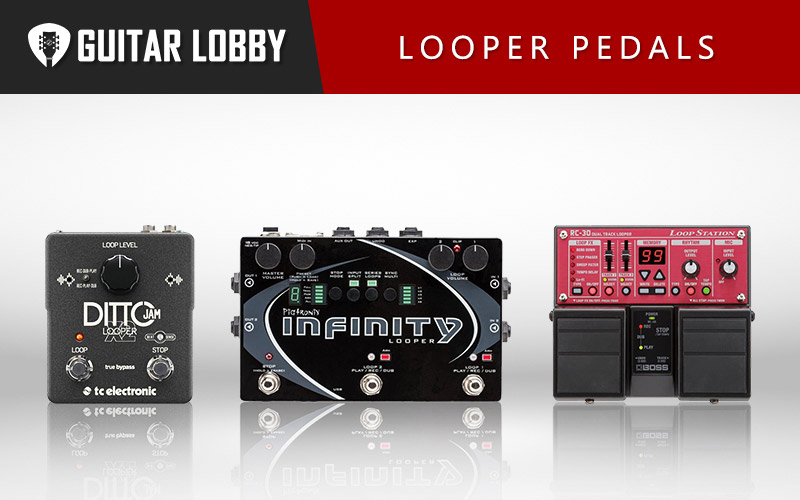
I’ll start this article by jumping straight into reviews on the best looper pedal at each price point, but if you want to learn more about them before reading reviews check out our looper pedal information guide at the bottom of the page.
| Name of Product | Image of Product | Description | Price Range | Full Review |
|---|---|---|---|---|
| 1. Boss RC-30 Loop Station (Best Overall) | 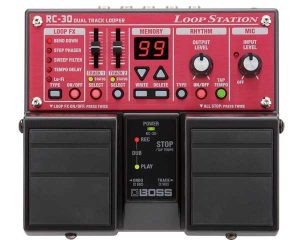 | Type: Digital Looper Pedal Looping Time: 3 hours | $300 | Read Full Review Below |
| 2. TC Electronic Ditto Jam X2 (Best Value) | 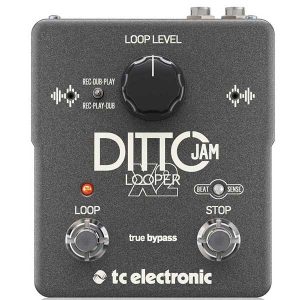 | Type: Digital Looper Pedal Looping Time: 2 minutes | $200 | Read Full Review Below |
| 3. Lekato Loop Station (Budget Pick) | 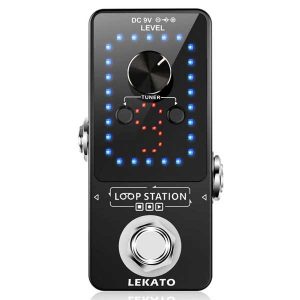 | Type: Digital Looper Pedal Looping Time: 40 minutes of recording time | $60 | Read Full Review Below |
| 4. MXR M303 Clone looper (Best Under $200) | 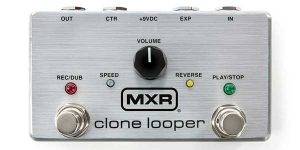 | Type: Digital Looper Pedal Looping Time: 6 minutes | $150 | Read Full Review Below |
| 5. Boss RC-1 (Best Under $100) | 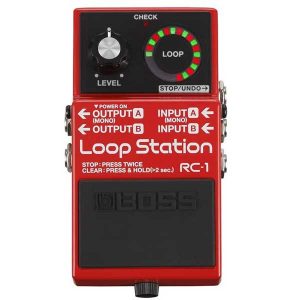 | Type: Digital Looper Pedal Looping Time: 12 minutes | $100 | Read Full Review Below |
| 6. Boss RC-300 Loop Station (Pro Choice) | 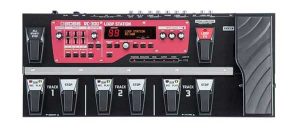 | Type: Digital Looper Pedal Looping Time: 3 hours | $580 | Read Full Review Below |
| 7. TC Electronic Ditto X4 | 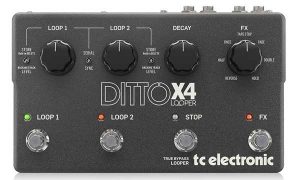 | Type: Digital Looper Pedal Looping Time: 5 minutes | $300 | Read Full Review Below |
| 8. Hotone Wally Looper | 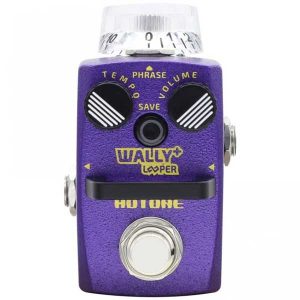 | Type: Digital Looper Pedal Looping Time: 330 minutes | $150 | Read Full Review Below |
| 9. Electro-Harmonix 720 stereo looper pedal | 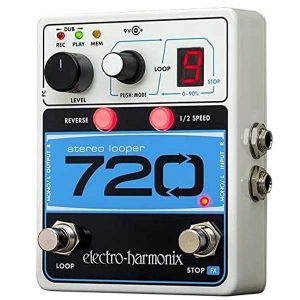 | Type: Digital Looper Pedal Looping Time: 12 minutes | $160 | Read Full Review Below |
| 10. VOX Lil’Looper | 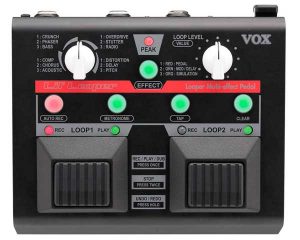 | Type: Digital Looper Pedal Looping Time: 1.5 minutes | $160 | Read Full Review Below |
| 11. TC Electronic Ditto Looper | 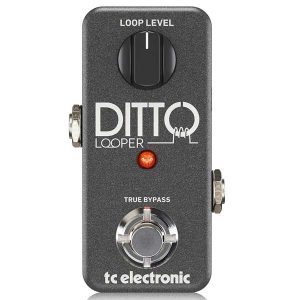 | Type: Digital Looper Pedal Looping Time: 5 minutes | $100 | Read Full Review Below |
| 12. Digitech Jam Man Stereo Looper | 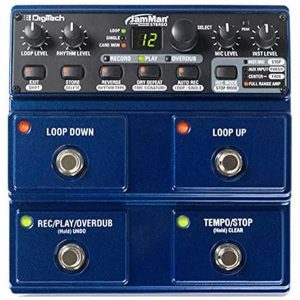 | Type: Digital Looper Pedal Looping Time: 35 minutes, expandable | $210 | Read Full Review Below |
| 13. Mooer Audio Micro Looper Pedal | 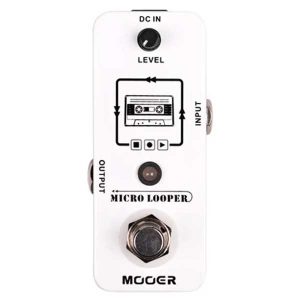 | Type: Digital Looper Pedal Looping Time: 30 minutes | $90 | Read Full Review Below |
| 14. Pigtronix Infinity Looper | 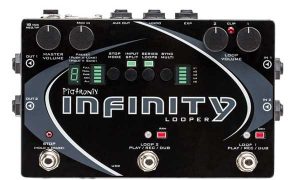 | Type: Digital Looper Pedal Looping Time: 2 hours, expandable | $450 | Read Full Review Below |
Here Are the Best Looper Pedals
1. Boss RC-30 Loop Station (Best Overall)
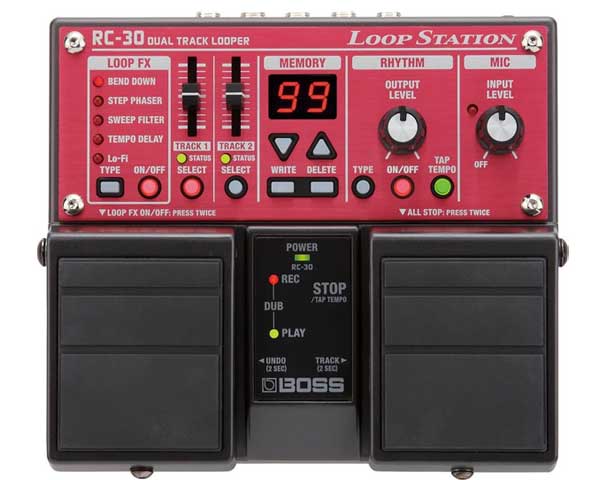
| Estimated Price | Just Under $300 |
| Type | Digital Looper Pedal |
| Looping Time | 3 hours |
| Effects | Dual track looper |
| Power | 9V PSU or 6AA 1.5V batteries |
| Connectivity | 6.35mm Jack R input, 6.35mm L/mono Jack input, 6.35mm R Jack output, 6.35mm Jack L/mono output, 6.35mm footswitch output, XLR microphone input, USB port |
My Review: As you probably already know Boss is one of the industry leaders when it comes to looper pedals. The RC-30 replaced the legendary RC-20XL which is still revered for being ahead of its time among loopers. The RC-30 is an extremely versatile and powerful dual-track looper pedal housed in the standard Boss twin-pedal chassis, placed at the higher end of the looper pedal price spectrum. It features 3 hours of total looping time stored in 99 phrases, true stereo inputs and outputs, XLR and USB inputs, and built-in loop effects. The dual-phrase loop feature lets you create play and stack two completely independent stereo loops in perfect sync. The volumes of each of the twin stereo tracks can be adjusted individually via the volume faders.
The loop effects section lets you add one of 5 effects to your loop: Bend down – Slows down the loop to half of its original tempo while also lowering the pitch by one octave, Step phaser – a combination between a phaser and a step sequencer, Sweep filter – adds a sweeping filter effect, Tempo delay – adds a delay effect, Lo-fi – adds a fuzz effect. The tap tempo function in the rhythm section of the pedal lets you set the rate for the time-based effects of the loop effect section. In the rhythm section of the pedal, you will be able to select one of 10 drum patterns, including real audio drum loops to accompany your loops. The RC-30 has an auto-quantize function ensuring your loops will have the perfect length and it enables you to change the tempo of your loop in real-time without any changes to its pitch. By connecting an external footswitch you will be able to browse through the 99 phrases of the RC-30’s memory bank.
The USB 2.0 port lets you connect the pedal to your computer, allowing you to import and export loops and backing tracks. The balanced XLR input, complete with Phantom power (if you use a condenser mic) enables you to plug in a microphone into the looper pedal and to add vocals or record acoustic instruments to your loops giving you even more creative options you will be able to experiment with. In addition to recording your instrument and vocal performances and turning them into playable loops, you can record other external stereo audio sources via the AUX in. Sound from a digital-audio player or other device connected to the AUX input can easily be recorded and added to your loops.
You can adjust the volume of the microphone input using the mic input level dial. The operation of the looper is pretty standard, rec>dub>play footswitch is located on the left side of the pedal while the right footswitch lets you stop the loop and tap in a tempo for your rhythm section or loop effects. Getting the right timing with a looper can be tricky sometimes but the RC-30 makes this easy: Auto recording starts to record your loop the moment you play your instrument while Count-in recording will start recording of a loop or after counting in a single 4-beat bar.
The Boss RC-30 Loop Station is a powerful looper pedal offering near limitless experimenting potential. If you are new to looping or a looping veteran, the RC-30 will not leave you wanting more. The great sound quality, great versatility, and intuitive interface make this one of the best looper pedals around.
Key Features:
- Powerful dual-track stereo looper with 3 hours of total recording time in 99 phrases
- 5 Loop effects to add to your loops as you please
- 10 Drum patterns you can use as timing guides
- True Stereo inputs and outputs, XLR mic input with Phantom power
- Auto-recording and Count-in recording modes help you get the perfect timing for your loops
2. TC Electronic Ditto Jam X2 (Best Value)
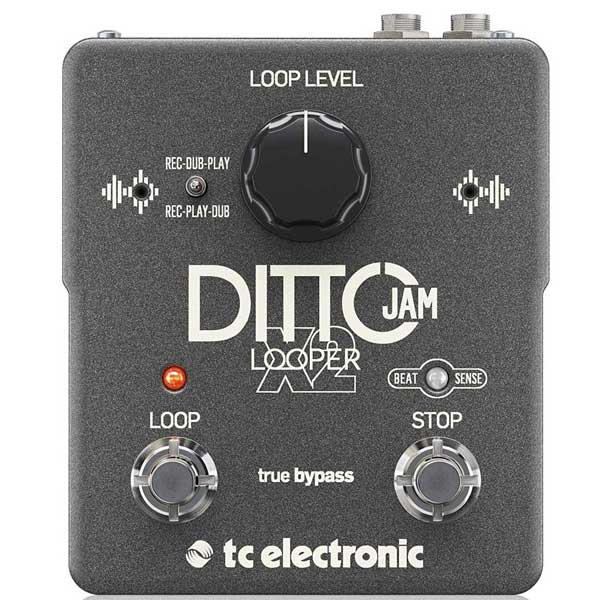
| Estimated Price | $200 |
| Type | Digital Looper Pedal |
| Looping Time | 2 minutes |
| Effects | Singletrack looper |
| Power | 9V PSU |
| Connectivity | 6.35mm Jack input, 6.35mm jack output, 3.5mm clip-on microphone input |
My Review: The release of the super-compact Ditto looper back in 2013 has been a huge success for TC Electronic, and as a result, they’ve constantly added to the Ditto line of pedals to become one of the major players in loopers. The Ditto line-up offers pedals for all levels of looping prowess, from the miniature Ditto to the more fully-featured Ditto X4 with 2 looping modes and 7 loop effects – they are all great pedals, all geared towards ease of use for the performing musician.
But the Ditto Jam X2 is a real game game-changer, addressing one of the major drawbacks of using a looper in a live situation: the band must follow the tempo set by the recorded loop instead of just following the drummer – this is more of a challenge than you might think. Here’s where TC Electronic invents something called BeatSense. The Jam X2 has 2 built-in microphones that automatically detect the tempo of the drums (mainly the snare drum on beats 2 and 4) and adjust the tempo of the loop to match the tempo set by the drummer. This means that the loop will always be in sync with the band, making looping in a live setting a breeze and also making the Jam X2 the first-ever looper to follow you instead of you following it. You also get an included clip-on microphone to attach to the snare drum or any other percussive instrument, very useful when playing live or in a noisy environment(as to not confuse the BeatSense algorithm). If you want to stray away from the 4/4 time signature, the X2 can do that also, as long as your time signature is based on quarter notes (3/4, 5/4, 7/4, etc.).
The Jam X2 has 3 looping modes, selectable with the stop footswitch: the BeatSense Mode, Practice Mode, and Classic Mode. When in BeatSense mode, the loop tempo is adjusted according to a rhythm acquired from a percussion instrument either with the dual built-in microphones or the clip-on mic. In Practice Mode the loop tempo follows the tempo of your guitar playing or a tempo you can tap on the stop footswitch – a great tool for practicing hard-to-nail-down passages. In Classic Mode, the Jam X2 functions as a classic looper pedal without any assistance or tempo adjustments.
The Jam X2 features 2 minutes of uncompressed 24bit looping time, which you’ll be hard-pressed to exceed, with unlimited overdubs, housed in the sturdy TC Electronic double-footswitch enclosure. You can choose between rec>dub>play and rec>play>dub modes using the overdub mode switch on the faceplate. When in rec>dub>play mode, tap the loop footswitch once to start recording your loop, tap it again to add overdubs, tap it a third time to playback your loop. In rec>play>dub mode you tap once to record, tap again to play that first loop, and tap again to start overdubbing. There’s a dedicated footswitch to stop your looping, this is a great feature in a looper as one-footswitch loopers make you double-tap to stop the loop playback, this could sometimes make you miss your mark.
The undo/redo function is accessed by pressing and holding down the loop footswitch for 2 seconds, this allows you to take out all of your overdubs, leaving only your first recorded loop playing, press and hold again for 2 seconds to bring back all your overdubs. You can choose between buffered bypass and true bypass through an internal dip switch.
The oversized volume knob lets you adjust the loop volume. There’s also a USB port you can use to export loops to your choice of DAW or to import your favorite loops and backing tracks straight to your pedal.
The TC Electronic Ditto Jam X2 is an awesome looper, ticking all the right boxes for simplicity and ease of use. On top of being an excellent basic looper, you can finally play with your band while looping, thanks to the BeatSense technology – a giant leap for looping-kind.
Key Features:
- BeatSense technology automatically adjusts the loop tempo to your playing
- Dual built-in mics accurately track band tempo by focusing only on rhythmic elements
- Dedicated stop button for easy control of loop endings
- Included clip-on mic for percussion instruments
- Analog-dry-through maintains total integrity of the analog dry signal even when the looper is engaged
3. Lekato Loop Station (Budget Pick)
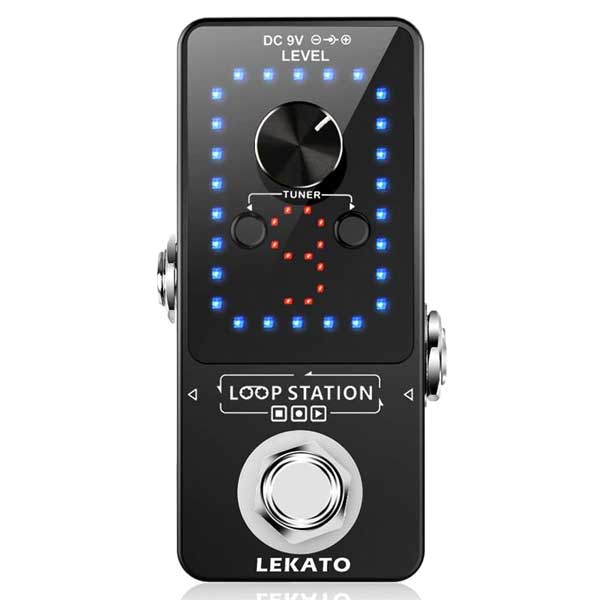
| Estimated Price | Under $60 |
| Type | Digital Looper Pedal |
| Looping Time | 40 minutes of recording time |
| Effects | Singletrack looper |
| Power | 9V PSU only |
| Connectivity | 6.35mm Jack input, 6.35mm jack output |
My Review: Lekato is a Chinese manufacturer of guitar accessories, offering very competitively-priced wireless transmitters, tuners, and microphones, now trying to expand its portfolio with super compact and well-built looper pedals. The Lekato Loop Station is the company’s more premium looper pedal, it is simple to use, well designed, and feature-packed. The looper is housed in a compact enclosure (original Ditto sized) and it also doubles as a decent guitar tuner freeing even more space on your crowded pedalboard. It features 9 individual banks to store your favorite loops and backing tracks, 40 minutes total recording time of uncompressed audio with 48kHz/24bit sampling rate, and a 10 minute limit per loop with unlimited overdubs.
The USB port lets you import and export loops to and from your PC/Mac using the included transfer cable, on the sides of the pedal you will find the ¼” input and output. On the faceplate, you will find the single volume control that adjusts the overall loop volume and the left and right buttons that allow you to select the desired loop from the memory bank, by pressing the arrow buttons simultaneously you engage the tuner. Tap the footswitch once to start recording, tap it again to play the recording in a loop, tap again to start adding overdubs, double-tap the footswitch to stop the loop. After you stop the loop you can delete it by pressing and holding the footswitch. It also has an undo/redo function, letting you remove your last overdub and adding it back in by pressing and holding the footswitch when in play mode. The nice thing about the Lekato Loop Station is that it has a LED display that lets you see when the end of the loop is coming back around – a feature not found on most of the looper pedals available.
When comparing the Lekato Loop Station to its main competitor (the Ditto Looper from TC Electronic) in the super-compact looper pedal category, the Lekato easily takes the win for versatility and functionality with its built-in tuner, 9 loop memory banks, LED display, and 40 minutes of total looping time. The build quality is excellent and at its price point of less than $60, it is unbeatable. If you are on a budget or new to looping or just want a fun little pedal to experiment with, the Lekato Loop Station might be the looper you are looking for.
Key Features:
- Compact looper with built-in tuner
- 48kHz/24bit sampling rate, lossless, uncompressed, professional tone quality
- 40 minutes of total recording time stored in 9 memory banks
- Rugged metal enclosure
- LED display lets you follow the loop length
Popular Related Article: Our 17 Favorite Reverb Pedals
4. MXR M303 Clone looper (Best under $200)
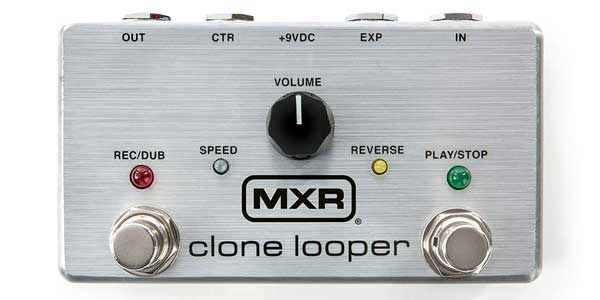
| Estimated Price | $150 |
| Type | Digital Looper Pedal |
| Looping Time | 6 minutes |
| Effects | Singletrack looper |
| Power | 9V PSU only |
| Connectivity | 6.35mm Jack input, 6.35mm jack output, 6.35mm footswitch output, 6.35mm expression pedal output |
My Review: MXR is well known for making high-quality pedals and the M303 Clone Looper is no exception to this rule. This stompbox really packs a punch for the size and the price. It is housed in the standard MXR enclosure but turned on its side, having enough space to fit its 2 separate footswitches used to control the looping functions of the pedal.
The M303 Clone looper features 6 minutes(when normal speed is selected) of high quality, high headroom, recording time with a 44.1kHz sample rate, and allowing for unlimited overdubs. It also has got 3 loop effects: Half speed (it slows down your loop and pulls it one octave lower), Double speed (plays your loop faster and raises it by one octave), and Reverse (replaying your loop backward). You can overdub on top of a reverse loop in the normal direction creating a mix of ethereal sounds and rhythmic phrases. The single volume knob controls the loop playback level. The VOLUME knob’s push function can also be used to change the speed of the loop and reverse it. Press once for Half-Speed and the blue LED will illuminate in a steady state. Double-press for Double-speed and the blue LED will start to flicker. Press and hold to reverse the loop and the amber LED will illuminate in a steady-state
The rec/dub footswitch controls the recording functions, by pressing and holding it down you will clear the loop, while the play/stop footswitch controls the playback function, press and hold it to clear the most recent overdub, press and hold again to bring it back in (undo/redo). The I/O panel features a ¼” input and output, a ¼” expression pedal input, that allows you to control the loop volume, and a ¼” input where you can plug in an external footswitch that will enable you to control the loop speed, loop direction and the play loop once function.
The M303 uses buffered bypass straight out of the box if you wish to enable true bypass you have to press down and hold the volume knob while powering up the pedal.
The MXR M303 is a very well designed looper pedal, it’s built like a tank, it gives you enough versatility in your looping options to satisfy the most demanding of looper pedal enthusiasts and it’s probably also the smallest 2-footswitch looper on the market today. All in all: a very flexible looper pedal offering top-notch sound and build quality, with a small footprint and at its price, kind of a bargain.
Key Features:
- Very compact 2 footswitch looper pedal
- 6 minutes of recording time at normal speed,(12 minutes at half speed) with unlimited overdubs
- 3 loop effects: Half-Speed, Double-Speed, and Reverse
- Selectable true bypass/buffered bypass
- Expression pedal and external footswitch inputs
5. Boss RC-1 (Best Under $100)
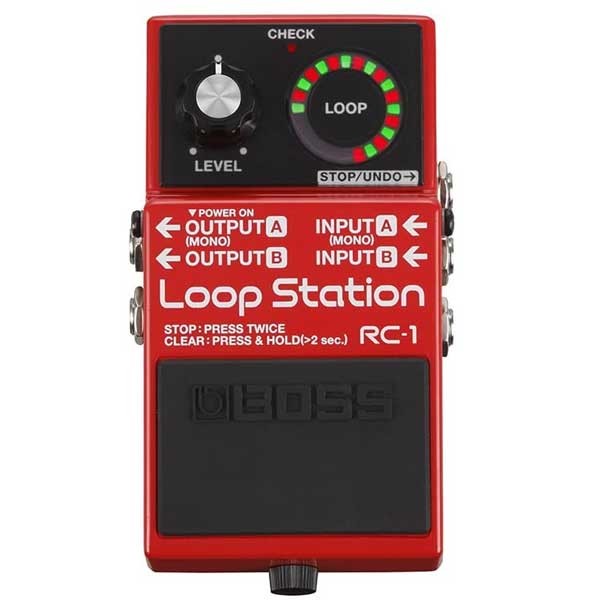
| Estimated Price | $100 |
| Type | Digital Looper Pedal |
| Looping Time | 12 minutes |
| Effects | Singletrack looper |
| Power | 9VPSU or 9V battery |
| Connectivity | 6.35mm Jack R input, 6.35mm L/mono Jack input, 6.35mm R Jack output, 6.35mm Jack L/mono output, 6.35mm footswitch output |
My Review: The bright red RC-1 Loop Station is Boss’s small footprint, entry-level looper, famed for its simplicity and straight forward use. As the more meager sibling of the RC-3, its feature set is quite limited, but as a basic looper, it’s hard to beat. You get 12 minutes of stereo recording time, with unlimited overdubs and it is housed in the classic, tank-like Boss stompbox enclosure.
The one really nice feature of the RC-1 is its 24-segment LED loop indicator, which lets you know when you are looping, recording, or overdubbing and it also shows the length of your recorded loop. There’s only one control knob on this pedal, letting you dial in the volume of the loop. On the right side of the pedal, there are three ¼” inputs, for operation in mono or stereo and one input for the attachment of an optional footswitch making this little looper even more versatile. On the left side, you’ve got mono and stereo ¼” outputs.
Straight out of the box, the RC-1 is set to record>overdub>play: hit the footswitch once and you start recording (loop indicator turns red), hit it again and it starts looping and will go into overdub mode (alternating red and green LEDs), hit it again and it will go into playback mode (green LEDs only). You can change this to record>play>overdub if you so choose. There’s also an undo/redo function: with a long press on the footswitch, you’ll remove all overdubs, leaving only your first recorded loop playing. Another long press and the overdubs are back. You stop the loop by double-tapping the footswitch. The sound quality is good enough for any live situation with a sample rate of 16bits. The RC-1 can be powered either by a 9V PSU or a (V block battery-allowing for up to 4.5 hours of continuous play.
The RC-1 is very simple and fun to use and the LED display is a great addition, this is simply a great looper pedal. In my opinion, this is easily the best looper pedal under 100 dollars.
Key Features:
- 24 segment loop indicator
- 12 minutes of stereo recording time with unlimited overdubs
- Loop volume control knob
Popular Related Article: Our 17 Favorite Electric Guitars Under $1000
6. Boss RC-300 Loop Station (Pro Choice)
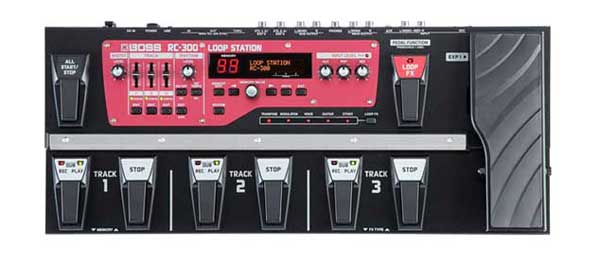
| Estimated Price | $580 |
| Type | Digital Looper Pedal |
| Looping Time | 3 hours |
| Effects | Triple track looper |
| Power | 9V PSU only |
| Connectivity | 6.35mm Jack R input, 6.35mm L/mono Jack input, 6.35mm R Jack output, 6.35mm Jack L/mono output, 2×6.35mm footswitch output, XLR microphone input, 6.35mm Jack headphone output, 6.35mm R Jack SUB output, 6.35mm Jack L/mono SUB output, MIDI input, MIDI output, MIDI thru, USB port |
My Review: The RC-300 is the top of the line Boss pedal and honestly a bit overboard for a casual guitarist using a looper as a practice tool. That said if the price isn’t a big factor for you this is an amazing pedal. The first thing you’ll notice with the RC-300 is its massive size, the pedal is over 21” wide and over 9” from the front of the pedal to the back. The RC-300 has a rugged metal construction, houses a total of eight-foot pedals, and has a built-in expression pedal to which you can assign different parameters.
It features up to 3 hours of internal recording stored in 99 memory phrases with unlimited overdubs, three synchronized stereo tracks with dedicated slider volume level controls for each. Every track has its own rec>play>dub and stop footswitches giving you total precision and control over your loops. In addition, there’s an “all start/stop” footswitch letting you start or stop all three loops at once. The dedicated loop FX footswitch lets you apply effects without having to take your hands off of your instrument. The RC-300 is packed with looping oriented functions, including one-shot, sample-like play, reverse playback, tempo-shifting functions, auxiliary inputs, different stop modes, rhythm tracks and undo/redo functionality. The Loop Station has a transpose function, allowing you to alter the pitch of your loops without changing the tempo. There is also a specific effect to turn your guitar into a bass, this could be useful for a one-man-band. The effects section of the RC-300 can be used with any of the three tracks independently, this means that you can assign a specific effect to only influence the track of your choice. Depending on how you split up the tracks for your loops, you can add wild pitch bends to a lead part without affecting the rhythm. You can also apply the effects to all tracks if you so choose. The RC-300 comes equipped with an entire battery of rhythm backing tracks that cover most musical styles and time signatures.
The 3-track layout of the RC-300 Loop Station has pushed Boss to improve the already numerous time synchronization features. Besides ensuring that your overdubs are always in time with the original recordings, the pedal can also make sure that your 3 tracks fit together nicely. The RC-300 will arrange your 3 tracks so that they start at the same time as the longest track, ensures that they are all in sync, and as a bonus, you can select which track you want the synchronization applied to.
When manipulating your loops, you have the option to choose between three handy stop modes: Immediate, End of the current loop, and Fade.
The basic operation of the RC-300 can be largely made hands-free, using the footswitches only. This is obviously a great advantage when you are looping live, and the ability to bring in and take out different tracks at will makes the RC-300 Loop Station suitable for complex, hands-free composition. There are a few functions that will require you to use your hands to operate this pedal properly, but these situations can be easily prepared for in advance.
The Boss RC-300 Loop Station is the most powerful, fully-featured looper pedal around. Unfortunately, all this innovation and versatility has its cost.
Key Features:
- 3 stereo tracks with dedicated footswitches and controls
- The expression pedal controls effects in real-time
- Up to 3 hours of internal recording time and 99 on-board memories
- 16 effects optimized for looping
- Balanced XLR out with Phantom power
7. TC Electronic Ditto X4
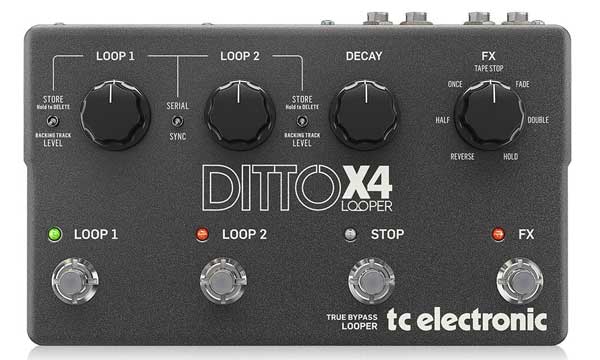
| Estimated Price | $300 |
| Type | Digital Looper Pedal |
| Looping Time | 5 minutes |
| Effects | Dual track looper |
| Power | 9VPSU only |
| Connectivity | 6.35mm Jack mono input, 6.35mm stereo Jack input, 6.35mm mono output, 6.35mm Jack stereo output, MIDI in, MIDI thru, USB port |
My Review: The Ditto X4 is TC Electronic’s flagship looper, primarily aimed at more experienced looping enthusiasts. It follows the philosophy of the original Ditto looper – looping made easy. At first glance, it looks like it could be a daunting task to master the Ditto X4, having a lot of features, but its design is such that you can use it very quickly out of the box. This is not a small nor light pedal, and it is built like a tank, being housed in the TC Electronic X4 enclosure. It comes with 4 control knobs, 4 footswitches, and 3 dip switches on its faceplate.
The Ditto X4 features 2 completely independent loops, each with its separate volume control and dedicated loop footswitches. The Loop footswitches let you record, overdub, play, and undo/redo all with the same switch without double-taps which is a godsend. There’s a Stop footswitch, this stops the playback of both loops simultaneously. The FX footswitch toggles the loop effects on/off.
The Decay knob is a very cool feature of the Ditto X4. Doing overdubs on a looper is like adding layers to a cake, as each new layer is added without the old ones going away, eventually, you will end up with too many layers cluttering up your sonic landscape. To prevent this clutter, you can use the decay control to remove old layers as new ones are added. Turning the decay fully clockwise will keep stacking your overdubs without removing any, as you turn the decay control counter-clockwise old layers will disappear faster as new ones are added.
The FX dial lets you add effects to your loops and there are 7 effects to choose from: Reverse – plays the loop backward, Half – plays the loops at half speed, Double – plays back the loop at double speed, Once – only plays back the loop once, Fade – the loop fades out slowly, Tape stop – adds a tape-delay-like warble before stopping, and Hold – a sample-and-hold-like stutter.
On the faceplate, you’ll find 3 dip switches. The 2 store/delete switches let you store one or both loops as backing tracks, enabling you to export them to your PC via USB port. The serial/sync switch lets you choose how the two independent loops interact with each other, flip the switch to serial and only one loop will play at a time, queueing up the second loop when the first one ends, switch it to sync and you can play them simultaneously or staggered. The Ditto X4 features 5 minutes of stereo 24bit uncompressed looping time – sound quality will not be an issue with this one. It can also sync to MIDI clock, making sure that your loops are always in perfect sync with external devices such as sequencers or drum machines.
The Ditto X4 features ¼” mono and stereo inputs and outputs.
The four dip switches let you decide how you want your Ditto to react. Switch 1 changes the default record > play > overdub order to record > overdub > play. Switch 2 changes the default overdub mode from being instant to starting at the end of your loop cycle. Switch 3 lets you switch between your loops instantly or at the end of a loop cycle in serial mode. Switch 4 changes the looper from true bypass to buffered bypass.
The Ditto X4 is a looping beast offering near-unlimited flexibility to the looping enthusiast in a straight forward package you can easily figure out without the manual.
Key Features:
- Dual loop tracks with 5 minutes of looping time
- Loop decay dial
- MIDI sync and control – for perfectly timed live loops
- True bypass/ buffered bypass with analog dry-through
Popular Related Article: Top 17 Delay Pedals
8. Hotone Wally Looper
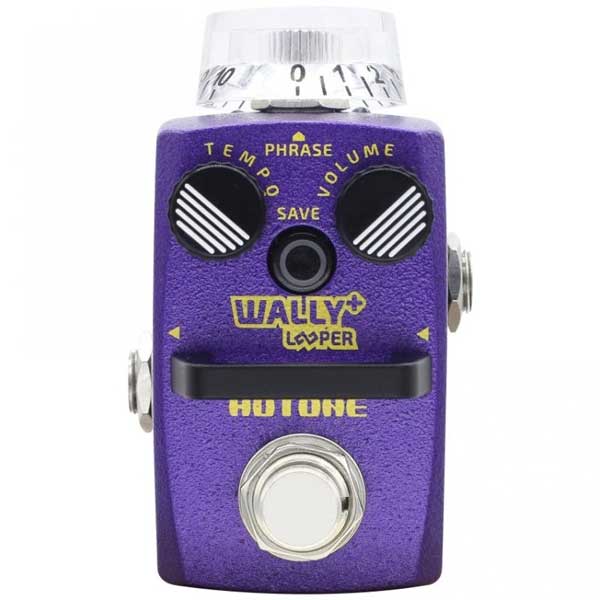
| Estimated Price | $150 |
| Type | Digital Looper Pedal |
| Looping Time | 330 minutes |
| Effects | Singletrack looper |
| Power | 9VPSU only |
| Connectivity | 6.35mm Jack mono input, 6.35mm mono output, USB port |
My Review: The Hotone Wally+ is one of the smallest loopers out there, and probably the most powerful for its size. This pedal is tiny, even compared to the already miniature TC Electronic Ditto but it really packs a punch. It is aimed at the guitar player who demands a quality looper without it taking up space on the pedalboard.
The sound quality is not quite up there with TC’s Ditto loopers but it’s not too far off.
It features 8GB of internal storage and 11 savable loop phrase banks with up to 30 minutes of loop time per phrase at a 24bit/44.1kHz sampling rate. The Wally+ also has a USB port enabling you to export and import loops to and from your PC or Mac using the included software. The single footswitch lets you control all the looping functions of this little powerhouse. A tap starts the recording, tap the footswitch again and the Wally+ will playback your recording in a loop, tap it once again and it starts layering overdubs over your first recorded loop. There is undo/redo functionality for the last recording by holding the footswitch down. To stop the loop, you have to quickly double-tap the footswitch. You can clear your loop after stopping it by then holding down the footswitch. If you want to save your loop into one of the 11 phrase banks, just use the large, transparent dial on the front of the pedal to select your desired phrase bank (from 0-10) and push the save button on the faceplate. The volume dial adjusts the loop volume. The cherry on top is the tempo dial, turning it clockwise will speed up your loop bringing it one octave higher while turning it counter-clockwise will slow down your loop bringing it one octave lower than your original loop. It has the same drawback that all one-footswitch loopers have: double-tapping to stop the loop can take some getting used to.
The Wally+ Looper is such a fun and easy to use pedal, the tempo dial brings lots of tonal versatility to the table and 11 phrase banks are unheard of in such a small package, you can’t go wrong with it.
Key Features:
- 24-bit 44.1kHz high-quality recording/playback
- 11 phrase banks for storing your loops with 30 minutes per bank
- 8Gb internal storage
- Import, export and manage your loops via USB using the included software
- Change the loop tempo on the fly
9. Electro-Harmonix 720 stereo looper pedal
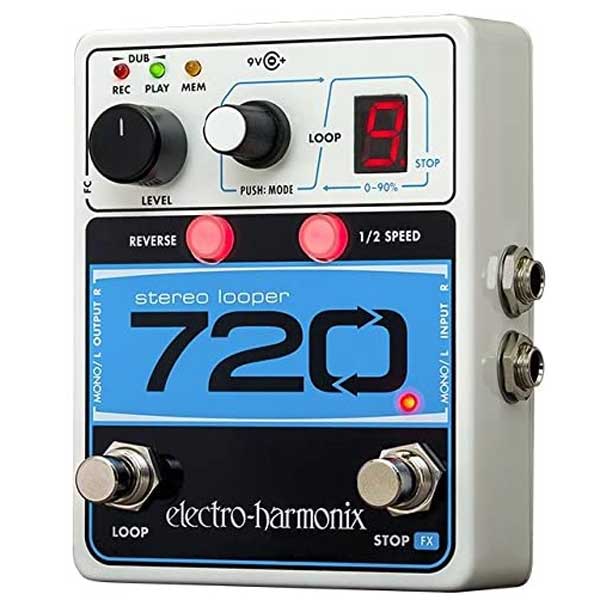
| Estimated Price | $160 |
| Type | Digital Looper Pedal |
| Looping Time | 12 minutes |
| Effects | Singletrack looper |
| Power | 9VPSU or 9V battery |
| Connectivity | 6.35mm Jack R input, 6.35mm L/mono Jack input, 6.35mm R Jack output, 6.35mm Jack L/mono output, 6.35mm footswitch output |
My Review: Electro-Harmonix has been moving away from the larger multi-track looping options in its lineup and towards the more simple and compact loopers as epitomized by TC Electronic’s Ditto. This new line of thinking led to the creation of the EHX 360 Nano Looper with 360 seconds of looping time but, due to its small size, with a relatively meager feature set. To offer a more comprehensive looping solution, with a more fleshed out offering, EHX created the 720 stereo looper.
The 720 doubles on the available memory compared to its smaller sibling, it also adds a dedicated Stop /FX footswitch engaging the effects section of the pedal. It features 12 minutes of stereo looping time in 24bit/44.1kHz uncompressed, high-quality audio, divided up between the 10 memory banks with infinite overdubs. After a loop is recorded, its length will be subtracted from the total loop recording time of 720 seconds. Pressing the Loop footswitch starts the recording of a loop, tapping the loop switch again will start looping, by tapping again you start overdubbing. You can select your preferred looping mode between rec > play > dub or rec > dub > play during power-up by pushing and holding either the ½ speed or reverse buttons. There are 2 effects you can add to your loop: “Reverse” will playback the loop in reverse, while “½ speed” slows down your loop and will drop it by exactly one octave. and you can use both of them at the same time. The undo/redo function is controlled by pressing and holding the Loop switch for 2 seconds. The loop volume can be set using the level dial. The Push:Mode dial cycles through the 3 different modes of the 720: “L”, “P” and “F”. “L”- Loop, lets you select one of the 10 available loop banks, “P”-Progress report, tells you where you are within the loop, and “F”-Fade, enables you to add a fade effect to your loop.
The STOP/FX footswitch can be set to either STOP mode or FX mode. Select either mode by pressing and holding the PUSH: MODE button for 2-seconds. When in STOP mode, a DOT appears on the display next to the STOP label. When in FX mode, the DOT is off.
The 720 can be run either in mono or stereo and it has a ¼” out where you can plug in an external foot controller giving access to the memory banks and the instant undo/redo function. It also comes with an included PSU.
EHX has made an instant classic with the 720 stereo looper, offering great-sounding loops with a lot of versatility in a compact and rugged enclosure and at this price point, it is very hard to beat.
Key Features:
- Stereo looper
- 10 memory banks
- High-quality, uncompressed audio, 24-bit A/D/A converters plus 44.1kHz sample rate
- Reverse and ½ speed effects at the touch of a button
- 9V PSU included
Popular Related Article: Top 27 Guitar Pedals (All Types)
10. VOX Lil’ Looper
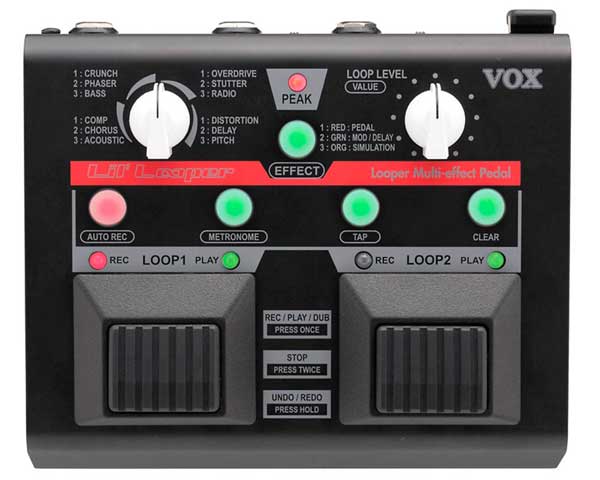
| Estimated Price | $160 |
| Type | Digital Looper Pedal |
| Looping Time | 1.5 minutes |
| Effects | Double track looper |
| Power | 9VPSU or 6AA 1.5V batteries |
| Connectivity | 6.35mm Jack input, 6.35mm Jack output, 6.35mm footswitch output 3.5mm jack headphone output |
My Review: A year after Vox launched the company’s first-ever looper pedal, the VDL-1 Dynamic Looper, they added another looper to their lineup. The aptly named Lil’ Looper shares many of its traits with its bigger sibling but at a more affordable price point and housed in a more portable enclosure double-footswitch enclosure that is much smaller than a Boss RC-30 for example.
The Lil’ Looper is a double channel looping pedal with an intuitive layout a 90-second combined loop time with infinite overdubs and 12 built-in effects that can be recorded into the loop. Don’t shy away from the 90-second loop limit, it is more than enough looping time for most standard looping needs.
The effects section is divided into 3 categories with 4 effects per category: Pedal (Compressor, Crunch, Overdrive, Distortion ), Modulation (Chorus, Phaser, Tremolo, Delay), and Simulation (Acoustic simulator, Bass guitar simulator, Radio-style EQ, Pitch shift ), each called up with the press of the center button which will light up in green, orange, and red depending on the category of effect you’ve chosen.
After you have chosen your effect category, you will be able to select one of the 4 effects within it using a rotary dial that is divided into 4 quadrants. Turning the dial clockwise in any effect’s quadrant will increase a crucial parameter until you reach the beginning of the next effect. In essence, it is both a looper and a versatile multi-effects pedal with good tone sculpting options, letting you explore and experiment with new sonic landscapes. It has a microphone input, should you wish to add vocal parts, acoustic, or percussion instruments to your loops.
The Lil’ Looper allows you to loop a recorded musical phrase while adding variations in the sound by using different effects that would otherwise have to be purchased as separate effects pedals. This is one of the most compact loopers to offer this kind of tech, which is great for when you are traveling or have a shortage of space. It is designed to provide an individual footswitch for each of the two loop-sections with intuitive and easy operation – tap once to record, play, and overdub, tap twice to stop, and hold down the footswitch to remove your last recorded overdub, hold the footswitch down again to add it back to your loop. The Loop Quantize function ensures that your phrases automatically loop on the beat.
The I/O panel on the front of the pedal features ¼” inputs and outputs, the 9V center negative DC-in, a 2-way toggle switch to select between microphone and instrument inputs, and a ¼” out for an external footswitch which will enable you to turn the effects on/off, select the effect type, stop the individual loops separately and delete phrases. There is also a headphone output that you can use to experiment in silence or listen to the built-in metronome while your guitar signal is sent to an amp. When out on the road, the Lil’ Looper can run on 6AA 1.5V batteries.
Vox’s particular view on what a looper pedal should be is very different from its competitors, the emphasis here being on the live performance aspect of looping instead of offering ways to import backing tracks and loops from your DAW.
The Vox Lil’ Looper stands out in the crowd and in a very positive way, with its small footprint, dual loops, intuitive design, and generous offering of loop effects compared to other loopers on the market, this is a looper you should take very seriously indeed.
Key Features:
- Two independent loops with 90-second looping time with unlimited overdubs
- The Loop Quantize feature ensures that your loops are on the beat
- 12 effects you can add to your loops
- Built-in metronome
11. TC Electronic Ditto Looper
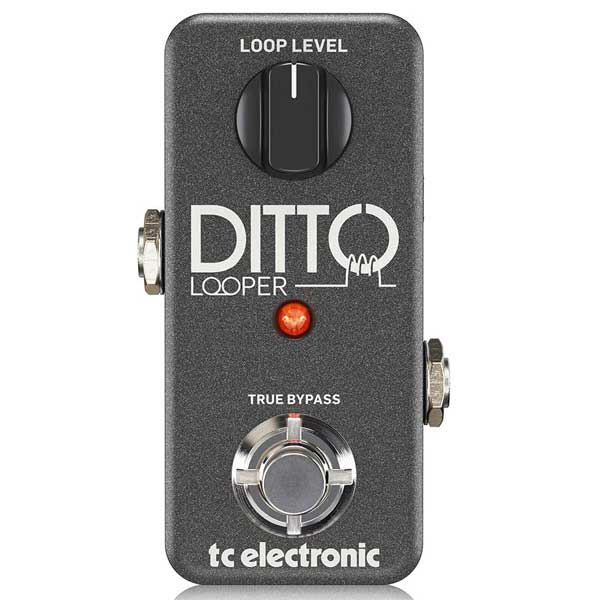
| Estimated Price | $100 |
| Type | Digital Looper Pedal |
| Looping Time | 5 minutes |
| Effects | Single track looper |
| Power | 9VPSU only |
| Connectivity | 6.35mm Jack input, 6.35mm Jack output |
My Review: When TC Electronic launched the Ditto looper in 2013 no one could have foreseen the resounding success it would have. The Ditto single-handedly revived the looper pedal and brought it to the masses. Following its acclaim, TC Electronic has constantly added to the Ditto family which, at this point includes 6 pedals, ranging from the miniature original Ditto to the flagship Ditto X4 looper sporting 2 completely independent looping channels. All the loopers in the Ditto line-up follow the same philosophy as the original: simple, rugged, powerful, no bells and whistles. There are few musicians that don’t have it or one of its siblings on their pedalboards.
The Ditto is simplicity itself in the smallest of packages. It features a ¼” input, a ¼” output, a footswitch, an LED that changes color depending on the function that the pedal performs, and a loop volume dial. Using the footswitch you can access all relevant looping functions: record, play, overdub, undo/redo, stop, and delete which is remarkable when you think about it.
The Ditto features 5 minutes of 24bit uncompressed audio recording time with unlimited overdubs.
Tap the footswitch once and you begin recording the loop (the LED glows red to indicate that the Ditto is recording), tap again to start playing back your loop ( the LED turns green). At this point, you can either jam and solo over your recorded loop or you can choose to overdub by tapping the footswitch again. The undo/redo function can be accessed by pressing and holding down the footswitch while in playback mode (this will remove your last overdub), if you want to bring back the overdub you’ve just removed, press and hold down the footswitch once more. To stop the loop you double-tap the footswitch, to delete your recorded loop you have to press and hold down the footswitch after you have stopped the playback.
The Ditto Looper also features an analog dry-through, ensuring that your dry signal passes completely through the pedal without ever being converted to digital and preserving your original tone. And it has a true bypass circuit meaning that your signal will lose none of its clarity and high-end when passing through the pedal while it is turned off.
Despite its size, the Ditto has everything that you need from a basic looper pedal: 5 minutes of high-quality lossless audio, straight forward operation, and a well thought out design, housed in a miniature, tank-like enclosure. The Ditto is already a legend.
Key Features:
- Ultra-small footprint
- Simple and straight forward operation
- 5 minutes of 24bit uncompressed high-quality audio with unlimited overdubs
- Undo/redo function
- True bypass and analog dry-through
Popular Related Article: 14 Best Guitar Tuners (All Types)
12. Digitech Jam Man Stereo Looper
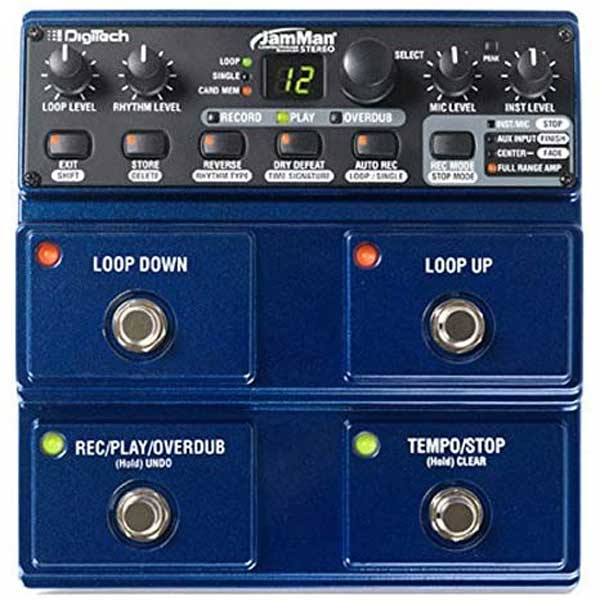
| Estimated Price | $210 |
| Type | Digital Looper Pedal |
| Looping Time | 35 minutes, expandable |
| Effects | Singletrack looper |
| Power | 9V PSU only |
| Connectivity | 6.35mm Jack R input, 6.35mm L/mono Jack input, 6.35mm R Jack output, 6.35mm Jack L/mono output, 6.35mm footswitch output, 6.35mm Rhythm output, XLR microphone input, 3.5mm Jack headphone output, 3.5mm Jack AUX input, USB port |
My Review: After the great success of the original rack-mounted JamMan in the early ’90s, offering full 8 seconds of looping time, expandable to 32 seconds, Digitech improved upon the original and brought out 3 new looper pedals: the JamMan Solo, JamMan Stereo, and JamMan Delay. With the JamMan Stereo probably hitting the sweet spot of bang for your buck.
The JamMan Stereo offers 35 minutes of 16bit/44kHz, CD-quality, stereo looping time, stored in 99 memory slots, expandable through the SD card slot which supports up to 32Gb memory cards and adds another 99 memory slots into the mix.
It uses the top two of its four footswitches to navigate through the 99 memory bank slots (this greatly increases the live-looping capability of the JamMan), while the bottom two pedals take care of the looping function of the pedal. If you want to record a loop, tap the rec/play/overdub footswitch once (the bottom left pedal) to start the recording of a loop, tap it again to continuously playback the loop, tap a third time to start overdubbing. To stop the playback, you simply hit the bottom right pedal, labeled “Stop/Tempo”. To delete the loop you’ve just recorded, press and hold the Stop/Tempo footswitch. To set the tempo of a loop, you just tap on the same Stop/Tempo footswitch.
The JamMan stereo is equipped with an Auto-Quantize feature, which automatically fixes your loops so that they are the perfect time. This is a very useful tool for those who have less than perfect timing or for anyone who’s new to loopers. Instead of relying on impeccably timed button-presses, the Auto-Quantize allows you to be a little off with your timing, and it will correct your mistakes. Another nice feature of the JamMan is its Time Stretching feature, this allows you to change the tempo of a given loop without also changing in the pitch of the loop.
On the faceplate of the pedal, you’ll find a comprehensive suite of controls: a loop level dial for adjusting the loop volume, a rhythm level adjusting the volume for the 9 preset drum patterns this looper comes equipped with, a mic level control adjusting the microphone volume, and an instrument-level volume control setting the input signal level for the Left (mono) and Right input jacks.
This is a true stereo looper pedal, offering ¼” Left(mono) and Right inputs and outputs. On the I/O panel, you’ll also find the XLR balanced Microphone input (doesn’t have Phantom power capability), a ⅛” headphone out, a ⅛” aux in enabling the creation of loops from any audio source, the SDHC card slot allowing for a maximum of 32Gb memory cards, and a USB port used to transfer sort and manage your loops on the computer.
To summarize: The JamMan Stereo is a feature-packed looper pedal that is very easy to use, is built like a tank, has 4 footswitches(2 for navigating through the memory bank, 2 for the looping function), has the live performer in mind and it’s almost $100 cheaper than its rival, the BOSS RC-30 Loop Station.
Key Features:
- 35 minutes of CD-quality looping time stored in 99memory slots
- SDHC card slot enables the expansion of the internal memory by up to 32Gb
- 4 footswitches, let you control the basic pedal functions without having to take your hands off of your instrument
- Mono and stereo functionality
13. Mooer Audio Micro Looper Pedal
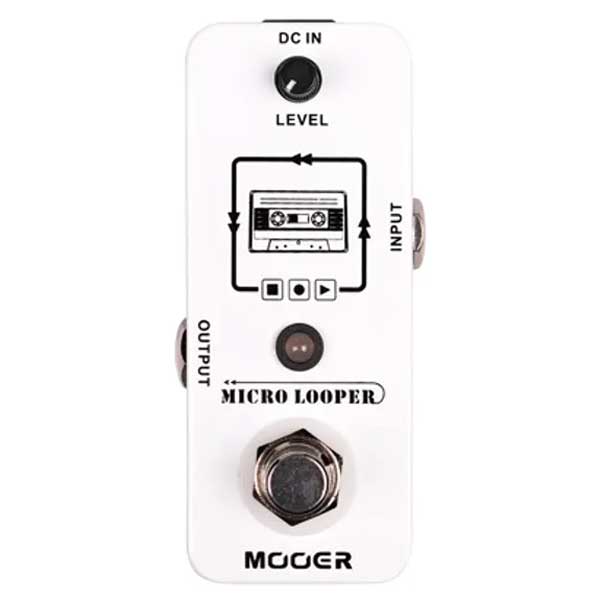
| Estimated Price | $90 |
| Type | Digital Looper Pedal |
| Looping Time | 30 minutes |
| Effects | Singletrack looper |
| Power | 9V PSU only |
| Connectivity | 6.35mm Jack input, 6.35mm Jack output |
My Review: The Mooer Micro Looper is, in most aspects, a clone of the Ditto looper, but an improved one. As with the Ditto, all loop related functions are achieved using the single footswitch: Tap the footswitch once to start recording, tap it again to end your recording and to go into playback mode, tap it a third time and you start overdubbing. To remove the most recent overdub, press and hold down the footswitch for 2 seconds, to bring back the overdub you have just removed, tap and hold down the footswitch again (undo/redo). To stop the loop playback, just double-tap the footswitch. If you want to delete your entire loop, you must first stop the looping with a double-tap, then press and hold down the footswitch to delete your loop.
The Micro looper shares its footprint with TC Electronic’s Ditto – both very compact loopers. It features 30 minutes of recording time with unlimited overdubs, the loop level knob adjusts the loop volume level. All in all, this is a rugged little pedal that could find a spot on any pedalboard, while the 30 minutes of looping time ensure that you’ll probably never max it out. It’s also got a true bypass circuit, that will keep your signal untouched when the Micro Looper is disengaged.
This is a simple, straight forward, no-frills looper pedal with good build quality and unnecessarily large recording time. Can’t go wrong with it.
Key Features:
- Micro-sized looper pedal
- Unlimited overdubs
- True bypass – to preserve your tone when the looper pedal is off
14. Pigtronix Infinity Looper
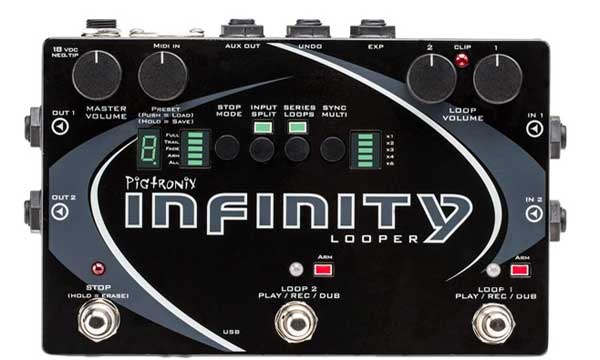
| Estimated Price | $450 |
| Type | Digital Looper Pedal |
| Looping Time | 2 hours, expandable |
| Effects | Dual track looper |
| Power | 18V PSU only (included) |
| Connectivity | 2×6.35mm Jack input, 2x 6.35mm Jack output, 6.35mm footswitch output, 6.35mm expression pedal output, 6.35mm Jack AUX output, MIDI input, USB port |
My Review: The Pigtronix Infinity Looper is deceptive in its apparent simplicity. At its core, the Infinity is a dual-track stereo looper whose recording capacity is only limited by the size of the SD card you stick in it. Each loop lets you seamlessly record, playback, overdub, undo and redo, so you have a lot of flexibility at your disposal. Once you’ve recorded a loop, the Sync Multi control will let you record a second loop with a loop length ranging from 1-6 times the length of the first loop you recorded. You can choose to run the loops either in parallel (like most loopers) or in series, making it easy to create complex grooves and build up songs quickly.
The Infinity Looper features 48kHz/24bit audio quality and unlimited overdubs. You can save dual loop content to one of 50 presets. On the face-plate, you can find the 2 play>rec>dub footswitches for the 2 separate loops, plus the dedicated stop footswitch. You’ve got a master volume dial, adjusting the output volume of the pedal, the preset selector dial, and 2 loop volume dials with a LED clip indicator, one for each track. The Infinity Looper brings a lot of potential for creativity and experimentation to the table.
To record a loop, hit one of the rec/play footswitches to start recording a loop. Tap the same footswitch again will send the looper into play mode, looping your recorded riff. Tap the same footswitch for the third time and the pedal will begin recording an overdub. The undo/redo function can be accessed through the use of an external footswitch.
The loops on the Infinity looper can be stopped in one of three ways: Full stop halts everything at once, the Trail stop causes a loop to stop automatically at the end of the current loop cycle The Fade stop, gradually fades out a loop from the moment the stop footswitch is hit, up until the end of the current loop cycle. By connecting an expression pedal to the looper you’ll be able to control the loop aging feature, among others. The loop aging is useful when you don’t want all your overdubs to clutter up your soundscape, It will remove the oldest recorded overdub while a new one is added.
The Pigtronix Infinity Looper is a high-quality, high-end looper pedal It’s very well thought out but requires extra footswitches and expression pedals to get the most out of it. Definitely a looper for those who are willing to experiment.
Key Features:
- Dual stereo looper pedal with intuitive looping functions
- You can run your loops in parallel or in series
- Sample accurate MIDI clock sync
- Looping duration is dependent on the size of the internal SD card
- On-board USB connectivity lets you upload and download your saved loops and configure your presets
Choosing the Right Looper Pedal (Buying Guide)
If you are interested to get into looping but are unsure about where to start, there’s no need to overly complicate things, just try to answer a few of these questions that will help nudge you in the right direction towards your first or your new looper.
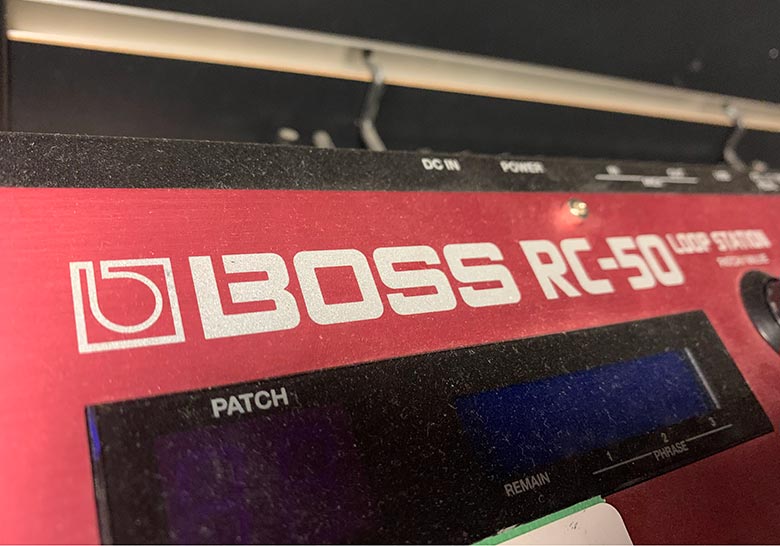
Why Use a Looper Pedal?
In principle, a looper will allow you to record yourself playing a rhythm track, then seamlessly play that rhythm back, “looping” it back to you infinitely, allowing you to jam along with yourself. You can also add new layers over your first loop, these are called overdubs. Most loopers let you record an unlimited number of overdubs. Removing the last overdub from your loop and adding it back in is called “undo/redo”.
Looping is a skill all by itself, requiring countless hours of practice to get the timing of your loops to be perfect, but it is a skill worth mastering. Just ask Ed Sheeran! He has become famous for using looper pedals in his live performances, allowing him to become a one-person band.
As a practice tool, a looper can be the best teacher you’ve ever had. Just record a few riffs and put your fretboard knowledge to the test by soloing on top of your loop. It could also help you with your songwriting, by playing you an endless loop to experiment until you’re satisfied with your composition without the need for a DAW(digital audio workstation)
Considerations When Choosing a Looper Pedal
Picking the right stompbox can be a daunting endeavor but picking the right looper pedal can be even trickier, as the pedal market has been flooded with looper pedals following the release and success of TC Electronic’s Ditto looper in 2013. Every reputable pedal maker that didn’t already have a looper in its line-up has brought out a simple, minimalist, and easy to use looper pedal with the smallest footprint they could cram their electronics into. Even legacy pedal makers like Electro-Harmonix, Boss, and MXR have jumped on the minimalist looper bandwagon. The upside is that your perfect looper is probably out there, the downside is you’ll have to dig a little until you will find it.
What will you do with your looper?
If you can figure out how you will use your looper, it will make things much easier choosing the right pedal for you. Loopers come in a wide price range, depending on the feature-set and options available. If you are new to looping, if you want a practice partner that doesn’t complain about endlessly replaying the same riff or if you just want a new, fun pedal to play around and experiment with, then perhaps a basic pedal might the right one to start out with. These basic looper stompboxes usually come in small enclosures, are very affordable, and offer enough versatility to satisfy most guitar players out there.
If you plan on performing live with a looper then you probably need multiple looping tracks, more memory to store your loops, added footswitches for increased looping precision, etc. Adding all this functionality will make for a bigger and bulkier pedal.
What is your budget?
Determining your budget can sometimes help guide you towards the right pedal as loopers come in a very broad price range. There are very affordable loopers, there are very expensive loopers and everything in between. It’s easy to get distracted by all the features these stompboxes are offering and you can easily spend a lot more on a pedal than you initially planned to. Sticking to a budget will make the process easier and save you a lot of time on top.
How much looping time do you need?
The length of the loop that the pedal can accommodate and store will determine how versatile it is and what you can do with it. A longer recording time will increase the options you’ll have available.
Looper pedals come with a looping time that is mostly not expandable, and the ones offering the added flexibility of memory expansion options usually cost a lot more, so figuring out if you need 3 hours of looping time to loop an 8 bar riff is cost-effective for your purposes. Most looper pedals on the market will offer enough looping time that you’ll have to force yourself to ever reach the looping time limit. For over 95% of guitar players, anything over 1 to 2 minutes of looping time will be overkill. And few loopers out there allow for less than 5 minutes of recording time with unlimited overdub layers.
Import and Export Sound clips?
If you want to import backing tracks into your looper or if you want to save your loops to your computer, then you need to look at loopers with USB connectivity. Many loopers let you import backing tracks but it isn’t a standard feature by far. Some loopers will erase your recorded loop once you power them off, while others let you save them
Do you need a dedicated stop footswitch?
The number of footswitches present on your pedal will greatly influence the way you use your looper. Small form factor, single-footswitch loopers are great for saving some pedalboard real-estate but due to their reduced size, all looping functions must be performed using taps, double-taps, and pushing and holding down the footswitch for a certain amount of time. To stop the looping on most single-footswitch looper pedals, like the Ditto, a quick double-tap must be performed, this is more or less standard. Many guitar players find the single-footswitch design a massive limitation. If you are performing live you want to be able to precisely stop your loops, so a dedicated stop footswitch might be the feature you will find most useful, and one you’ll welcome in your live performance.
There are pedals out there that let you expand their capability by connecting external footswitches, giving you more control over your looper.
Is pedal size important to you?
If you are a gigging musician and have to carry all of your gear, then you’ll probably lean towards the smallest and lightest pedal that does the job, in the most efficient manner possible. If your looper will stay in your home or in your studio, pedal size and weight won’t be that much of an issue for you.
Loop effects
Some looper pedals let you apply effects to the loop you have recorded without affecting your dry signal. The more widespread loop effects you’ll encounter include: Reverse – this effect will playback your loop backward creating a strong contrast between your dry signal and the loop, Half-speed – will half the original tempo of your loop and lower its pitch by one octave, Double-speed – doubles the tempo of your original loop raising its pitch by one octave, Play once- will play the loop once before stopping, Fade – starts to fade out the loop. Some loopers even let you apply more than one effect at a time. While experimenting with loop effects can be fun to play around with and can yield interesting creative ideas, you’ll probably use them sparingly at best. So basing your choice of looper on the loop effects options it comes with, is not recommended.
MIDI sync
Some loopers that let you sync your loop tempo with your other time-based hardware like drum machines or sequencers through MIDI sync. This ensures that all your gear plays in sync. If this feature is important to you then your options are likely limited to the higher end of the price range.
Features you are likely to find on a good looper pedal:
A sturdy metal enclosure quality footswitches will ensure that your looper will survive constantly being tread-on.
Some loopers let you select between buffered bypass and true bypass. This affects how your signal will pass through the looper and is a neat option to have. Depending on where you place the looper in your signal chain or how long your signal chain is, you would want to choose one or the other. For long signal chains, it is recommended that the first and last pedal in the chain should be buffered for your fundamental tone to be preserved.
There are looper pedals that let you choose the order in which your looper records, overdubs and plays back the loop: rec>dub>play and rec>play>dub. These three actions are usually performed by the same footswitch.
Audio quality is an important factor in a good looper pedal, luckily 24bit audio at 44.1kHz is somewhat of a standard among loopers.
A dedicated stop footswitch is great to have when performing live and you want to end the loop on cue.
Some loopers feature LED displays that let you instantly know if you are recording, playing back, overdubbing or how long you have until the end of your loop – this is a welcome function to have when you are overdubbing on a long and repetitive loop.
Wrap Up:
That does it for this review, let us know what you think is the best looper pedal below, and if there is one we left off that you feel should be on this list, let us and everyone else know in the comments below!

My name is Chris and I’ve had a passion for music and guitars for as long as I can remember. I started this website with some of my friends who are musicians, music teachers, gear heads, and music enthusiasts so we could provide high-quality guitar and music-related content.
I’ve been playing guitar since I was 13 years old and am an avid collector. Amps, pedals, guitars, bass, drums, microphones, studio, and recording gear, I love it all.
I was born and raised in Western Pennsylvania. My background is in Electrical Engineering, earning a Bachelor’s degree from Youngstown State University. With my engineering experience, I’ve developed as a designer of guitar amplifiers and effects. A true passion of mine, I’ve designed, built, and repaired a wide range of guitar amps and electronics. Here at the Guitar Lobby, our aim is to share our passion for Music and gear with the rest of the music community.

It’s a shame you link to the Ditto + video but review the Ditto classic instead. The Ditto + has the extended looping feature and enough storage space to emulate 99 Ditto pedals for the price of two. It’s a best under $200 pick for sure.